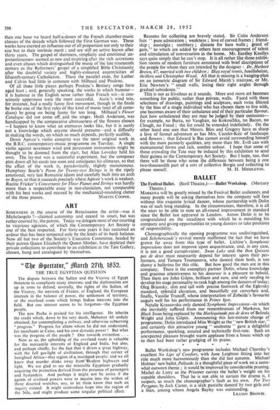ART
SOMEWHERE in the course of the Renaissance the artist—was it Michelangelo ?—claimed autonomy and ceased to court, but was rather courted by, the patron. Today we delegate most of our courting to vicarious agencies, of which the Contemporary Art Society is one of the best respected. For forty-one years it has sustained an ardour that has been tempered only by the limits of its bank balance. Now all but two of the. Society's Executive Committee, headed by their patron Queen Elizabeth the Queen Mother, have depleted their private collections to contribute to an exhibition at the Tate Gallery, chosen, hung and catalogued by themselves. Reasons for collecting are bravely stated. Sir Colin Anderson lists "pure admiration • weakness ; love of carved frames ; friend- ship ; nostalgia ; snobbery ; distaste for bare walls ; greed of gain," to which are added by others here encouragement of talent and stimulation of conversation in the home. Mr. Eardiey Knollys says quite simply that he can't stop. It is all rather like those exhibi- tion rooms of modem furniture annotated with brief discriptions of the people for whom they are intended by the designer : Dr. Herbert Brown, 47, married with two children ; likes royal tennis, bouillabaisse, thrillers and Christopher Wood. All that is missing is a hanging-plan on an isometric diagram of Sir Edward Marsh's staircase, or Mr. Eric Newton's "small walls, losing their right angles through gradual subsidence."
This is not as frivolous as it sounds. More and more art becomes something for public, rather than private, walls. Faced with these selections of drawings, paintings and sculpture, each twice filtered by the bias of a single individual who has chosen them to live with, one becomes aware of their unbalance and of their particular flavour. Just how unbalanced they are may be judged by their omissions— for example, no Burra, no Vaughan, no Kokoschka, no Bacon, no Clough, no Freud ; the list could be extended indefinitely. On the other hand one sees that Messrs. Bliss and Gregory have as sharp a love of formal adventure as has Mrs. Cazalet-Keir of landscape and flowers ; that Edward le Bas cannot avoid surrounding himself with the most painterly qualities, any more than Mr. Evill can with monumental forms and rich, sombre colour. I hope that some of those crowding the Tate may be induced by this exhibition to send their guinea to the Contemporary Art Society. But! hope, too, that there will be those who sense the difference between being a one two-thousandth part of a sort of collective Borgia and collecting to


































 Previous page
Previous page